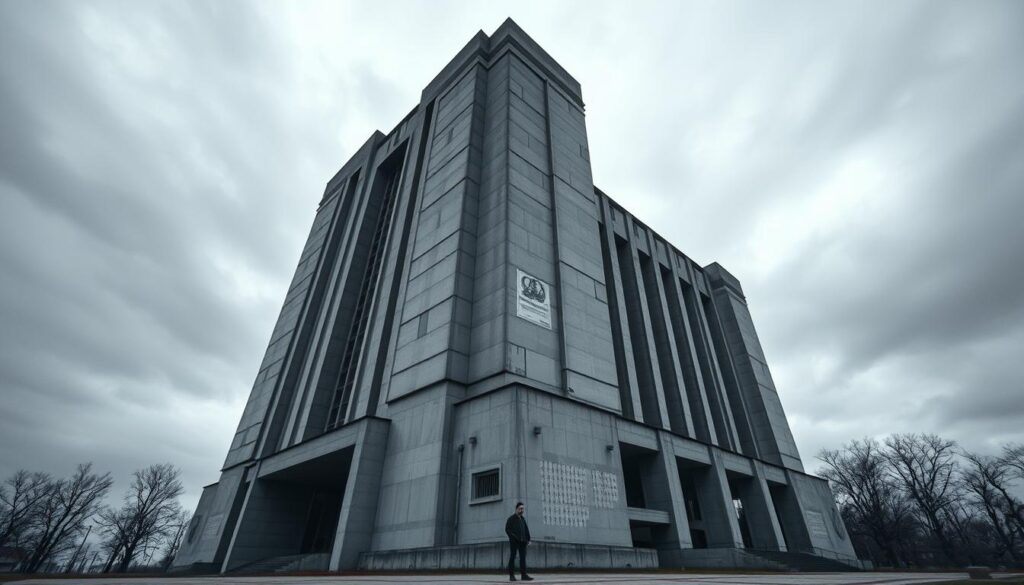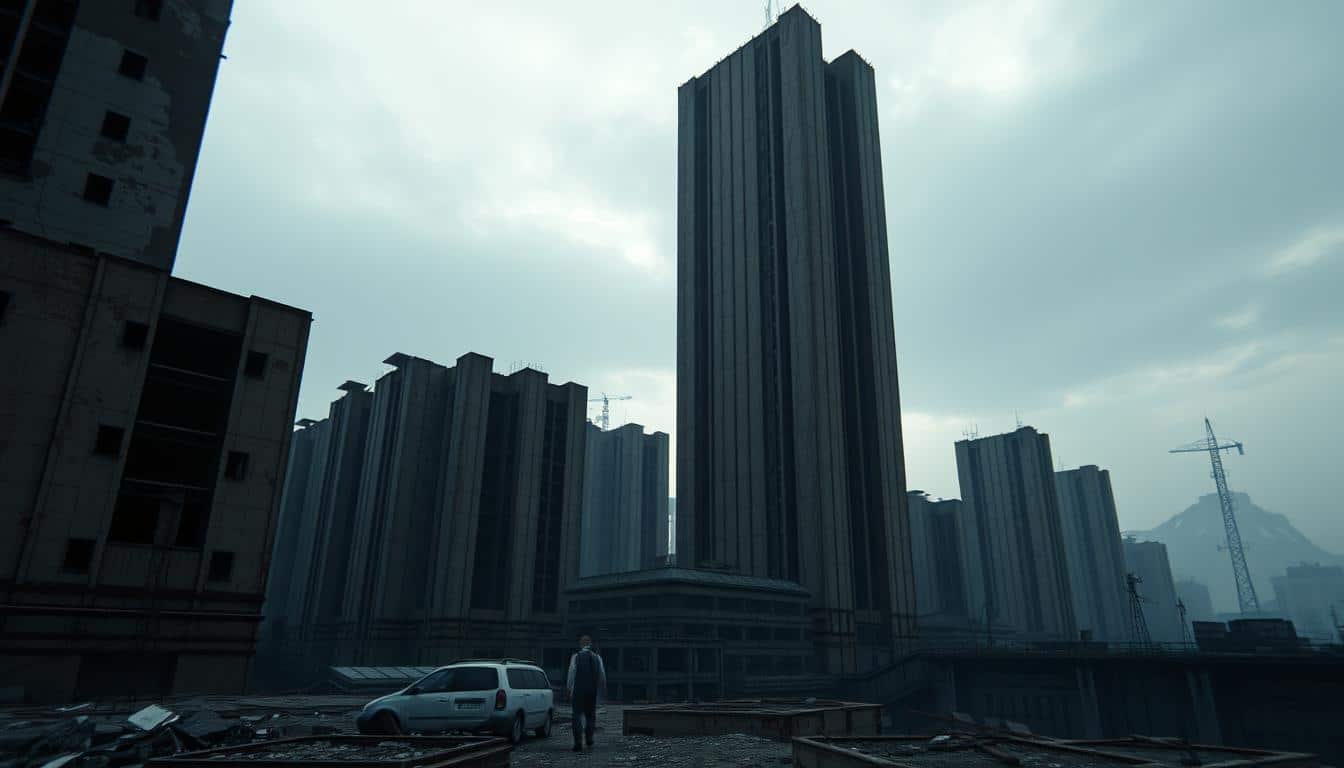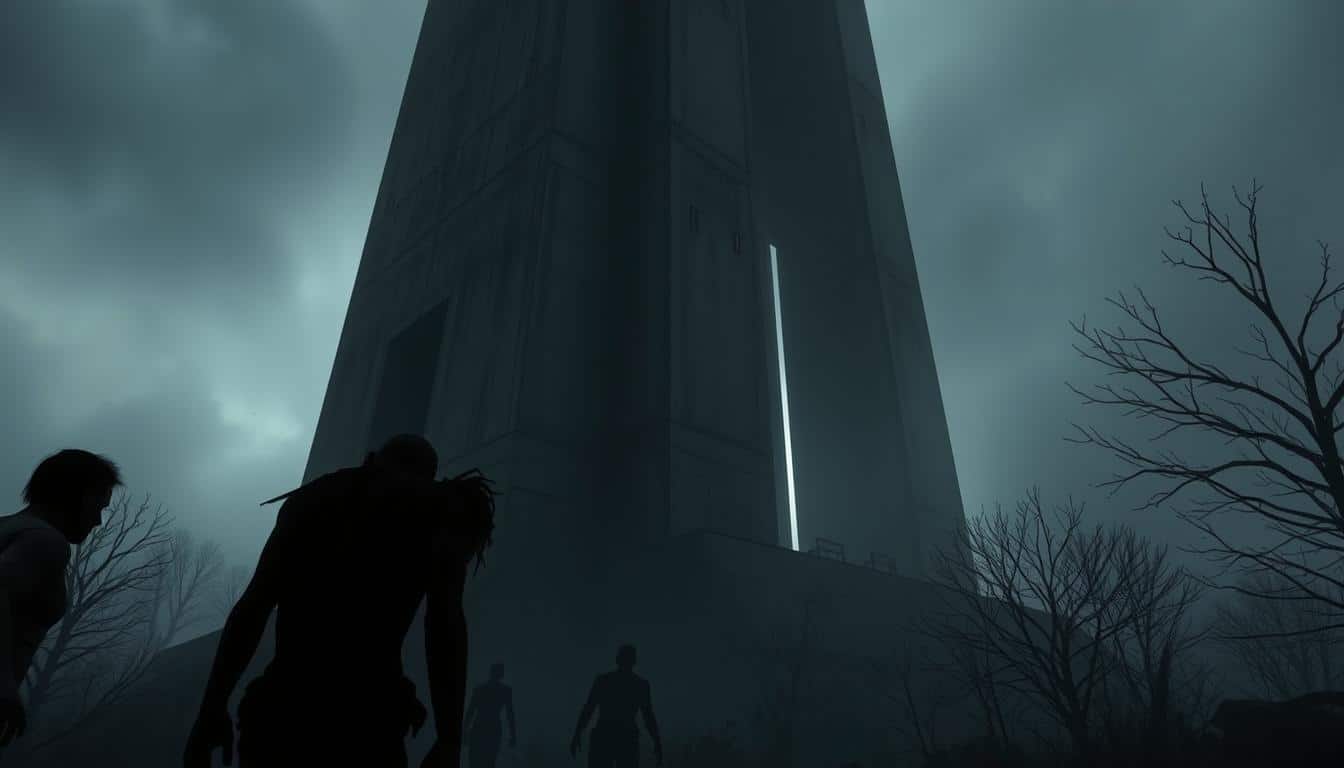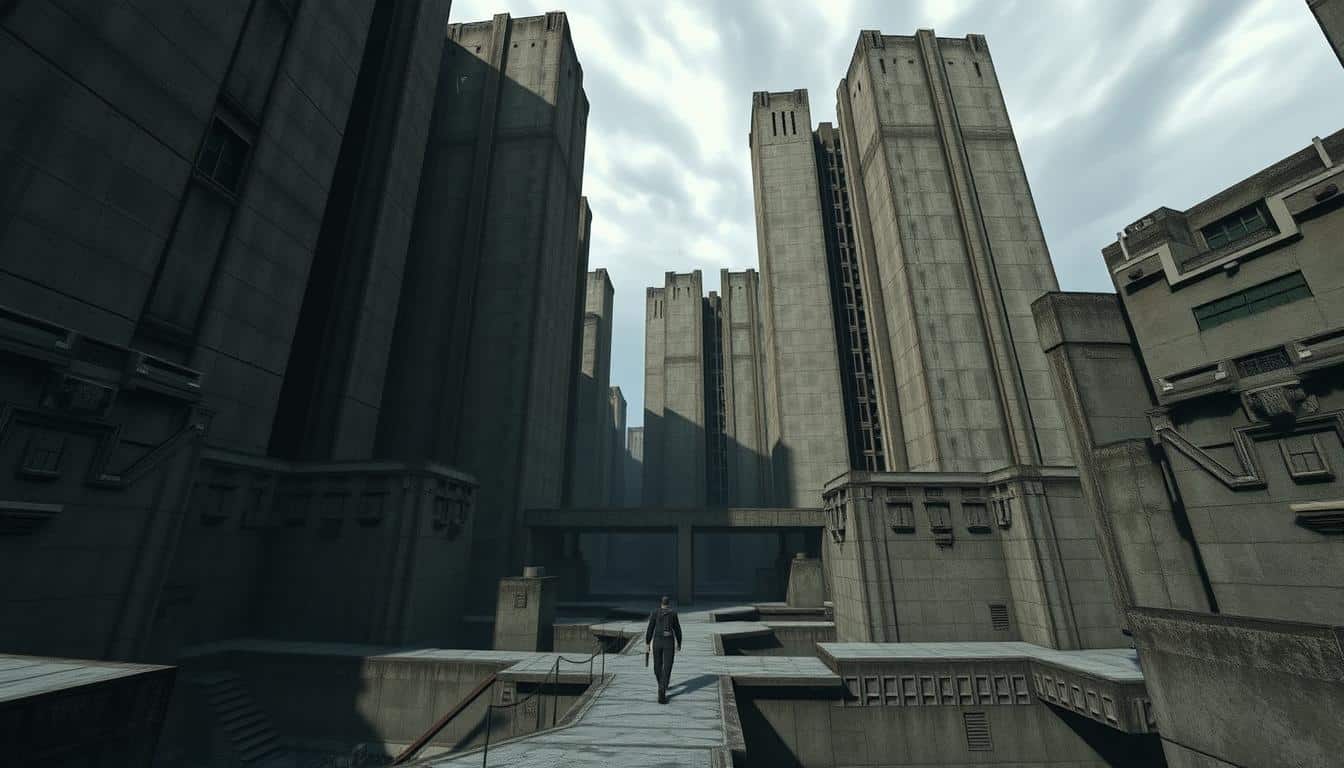Soviet brutalism is known for its raw concrete look and practical designs. It has deeply influenced different creative areas, especially games and apps. This part introduces how Soviet brutalism’s architectural themes have been woven into interactive entertainment. It has influenced both how games are played and their stories are told visually. The next sections will explore the history, look, and growing impact of this style. We’ll look at how it shapes well-known games and apps today.
Introduction to Soviet Brutalism
Soviet brutalism began after World War II. It’s known for simple, geometric shapes and lots of concrete. These features showed the culture and politics of the Soviet Union. The style’s history shows it was meant to display strength, usefulness, and a new direction from old, elaborate designs.
This style chose function over fancy looks, making buildings that were plain but striking. It often used local materials, making each building feel real and connected to its place. Soviet brutalism changed cityscapes and affected how people lived together. Its influence is still seen today, including in video games and apps.

The Rise of Brutalist Architecture
Brutalist architecture started in the 1950s UK for rebuilding after World War II. It used raw concrete and a simple look, fitting a society needing to recover. Key architects like Le Corbusier helped shape this style, affecting both the UK and Soviet architecture.
This style was a bold move away from earlier, fancy designs. It mixed usefulness with art in a new way. The buildings showed strength and function in their big shapes and open materials. They were more than just buildings; they showed the dreams of a post-war society.
As brutalism grew, it mixed with deeper ideas. Architects thought anew about space, community, and identity in their work. This led to buildings that were both social comments and answers for housing and public use. This chapter in architecture was a key answer to the need for rebuilding cities in the mid-20th century.
Understanding the Aesthetic of Soviet Brutalism
Soviet brutalism’s look is defined by its design rules. It mainly uses thick concrete and shapes that lead to unforgettable buildings across former Soviet lands. The main goal is usually practicality, leading to public buildings that also make strong statements.
Key examples are the massive Palace of Culture and Science in Warsaw and the towering Buzludzha Monument in Bulgaria. These buildings show the cultural impact of Soviet brutalism. They display a devotion to being monumental, aiming to uplift people. The large plazas and shared spaces in many designs act as meeting spots, highlighting the era’s community spirit.
However, some criticize these designs for feeling too cold. They say the bare materials and bold lines make places feel uninviting. This contrast is essential in games, where mixing impressiveness with a welcoming feel is key to keeping players interested. Understanding both the culture and criticisms of Soviet brutalism helps us better enjoy its special look in games.
Soviet Brutalism Themes in Interactive Entertainment
Soviet brutalism themes bring a unique vibe to video games. They mix history with game design, giving players a rich experience. This style makes games more than fun. It invites players to think deeply about history while playing.
Engagement of Players through Historical Context
Adding history to games makes them more engaging. Games set in the Soviet era connect players with that time’s challenges. This approach helps players see the world from different angles. They learn about history in an interactive way.
Visual and Audio Elements that Define the Experience
Visual and sound design are key in these games. A simple color scheme and bold shapes capture the feel of Soviet brutalism. Eerie sounds and special tunes add to the mood. Together, they make the game’s world unforgettable.
Notable Games Featuring Soviet Brutalism
Several games explore the aesthetic and themes of Soviet brutalism, offering players unique experiences. A standout game is HROT, a first-person shooter by a talented Czech developer, Spytihněv. It takes place in a dystopian Soviet Czechoslovakia. Here, players find themselves surrounded by the stark, imposing designs of brutalist architecture.
HROT: A Deep Dive into a Unique FPS
The game HROT takes a deep dive into Soviet brutalism. Players move through environments that reflect the era’s iconic structures. These settings are filled with historical references and creepy, supernatural aspects. They do more than set the scene; they make the game more immersive, enhancing the story through detailed level exploration.
How HROT Uses Brutalist Architecture to Enhance Gameplay
In HROT, brutalist architecture does more than look striking; it’s key to the gameplay. The game’s levels are like mazes, making players think and plan their moves in complex spaces. With propaganda elements spread around, the game builds a strong, historical atmosphere. This mix of design and game mechanics connects players more deeply to the story. It creates an immersive experience that fans of FPS games and Soviet culture will love.
Exploring Apps Inspired by Soviet Brutalism
Soviet brutalism has impacted more than just buildings, reaching into app design. Apps today use its minimalist and functional style. They feature simple lines, bold colors, and put use first.
Apps inspired by brutalism offer more than just utility. They give users a feel of the strict and stark brutalist structures. Categories of these apps include:
- Architectural design applications that allow users to experiment with brutalist-inspired layouts.
- Gaming apps that incorporate visual elements reminiscent of brutalism, enhancing thematic storytelling.
- Art apps that encourage users to create in a minimalist style, aligning with Soviet aesthetics.
These apps blend function with minimalist design, engaging users. They celebrate Soviet brutalism’s impact while drawing in various users. The mix of architecture and app design breeds creativity and new ideas.
The Impact of Soviet Brutalism on Game Design
Soviet brutalism has deeply influenced modern game design. It guides how makers shape the look and play of games. They pull from its architecture to add feelings of isolation and practicality. This invites players into new worlds.
Games touching on Soviet brutalism use a simple, strong visual style. It draws players into deep emotional journeys. It also makes them think about society and their own stories. Let’s look at how Soviet brutalism changes game design:
- Atmospheric Settings: Harsh settings mirror deep emotions, making players see things differently.
- Structural Gameplay: The gameplay is direct and simple, like brutalist buildings, making games fun and interesting.
- Narrative Depth: The themes of practical use are in the stories, letting players think about tough choices in bleak places.
This blending of elements doesn’t just show off Soviet brutalism’s architectural roots. It also makes gaming a richer experience. As creators dig into these ideas, game design becomes a thrilling area for new ideas and thinking.
Player Reception and Cultural Commentary
Soviet brutalism in games has led to significant attention from players. Titles showcasing this architectural style draw players into stories that mix history, art, and play. This interaction sparks deep discussions in the gaming community.
Players dive into what these games mean and how they impact today’s world. They share their thoughts and what these games say about society.
Community Engagement with Soviet Themes
Online spaces buzz with talks about Soviet themes in gaming. Gamers from all walks of life share their views on games’ brutal and authoritarian themes. These talks show different views, making everyone understand the games’ cultural backgrounds better.
Gamers are posting critiques and their takes, adding to a wide-ranging conversation. They also tell personal stories, adding depth to these games. This sharing creates a sense of togetherness among those who value the art and history in games.
Special forums discuss how players feel about games with Soviet brutalism. These talks uncover deeper meanings, urging players to think about the societal messages in these games.
Future of Soviet Brutalism in Games and Apps
The future of Soviet brutalism in gaming is thrilling for developers and gamers alike. As technology advances, new paths open for adding this distinct architectural style into games and apps. Developers can use trends in graphics and virtual reality to create worlds with the unique look of Soviet brutalism.
This could lead to new ways of telling stories in games. Players might explore stories about dystopia or teamwork, diving deeper into these ideas. By using sound and visuals, games can make players feel the mood of Soviet brutalism. This adds depth to the gaming experience.
Also, this style is versatile, fitting many game types, from adventures to puzzles. Bringing Soviet brutalism into modern games allows for creativity and adds new cultural insights. It makes games more interesting and meaningful.
Comparative Analysis with Other Styles
Soviet brutalism differs a lot from styles like modernism and minimalism. Looking closely at its unique features helps us see its special place. It also shows how it connects and differs from other designs.
What makes brutalism stand out is its bold, concrete look and focus on pure use. Modernism, in contrast, likes smooth lines and refined shapes. Minimalism, though, aims for the bare essentials to achieve simplicity. Brutalism, however, is all about making a big statement with its size.
When comparing architecture, consider these points:
- Material Use: Soviet brutalism shows off bare concrete. This is different from modernism’s glass and steel.
- Design Intent: Modernism uses open spaces to enhance life. Brutalism, though, makes you notice and think because of its bold presence.
- Aesthetic Philosophy: Minimalism seeks calm with simplicity. In contrast, brutalism goes for a bold and sometimes edgy look.
This look into architecture shows a world full of different ideas and creativity. It’s great for game and app makers to explore these various styles for inspiration.
Conclusion
In summary, exploring Soviet brutalism in games and apps shows a style that deeply affects gameplay and stories. This unique look not only draws in players but also makes them think about history, making their experience richer. The strong visuals of Soviet brutalism match themes of resilience, adding more meaning to the games that use it.
The influence of Soviet brutalism on entertainment is huge. It shapes how games are designed and how players feel when they play. Games like HROT show how developers use brutalist themes in their creations. This style can make players feel, think, and see things in new ways. It’s a strong way for game makers to tell their stories.
Looking ahead, Soviet brutalism in games is likely to keep being important. Game makers will keep finding new ways to use its features, creating experiences that speak to many people. This style is more than a passing trend. It’s a way for artists and storytellers to express themselves. It will continue to influence how games are made for a long time.



